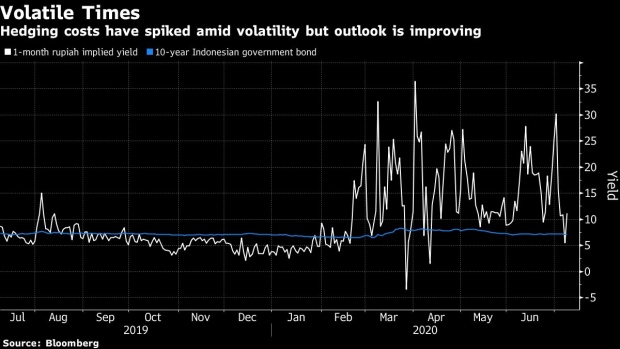Jul 9, 2020
Four Reasons Why Indonesia Bonds May Recover Mojo
, Bloomberg News

(Bloomberg) -- Indonesian bonds have been stuck in a trading range over the past month but the convergence of several positive factors means their outlook is looking increasingly positive.
Sovereign debt in Southeast Asia’s largest economy may lure investors due to the potential for hedging costs to move lower, the favorable balance of positioning, and their relatively attractive carry. At the same time, concern that a potential increase in the money supply will cause the rupiah to weaken appears overdone.
1. Hedging Costs
Real-money investors looking to buy Indonesian bonds without the accompanying currency volatility were largely shut out of the debt market earlier this year as hedging costs surged amid the coronavirus outbreak.
While the one-month implied yield for the rupiah has swung tremendously since then, there are signs it is starting to regain some stability as investors have become a bit more sanguine about the long-term impact of the pandemic. Given time, the yield is likely to settle back close to, or even below that of Indonesian 10-year bonds -- where it was until its February break-out -- reducing hedging costs and luring back more overseas buyers.
2. Attractive Carry
Indonesia’s bond yields are among the highest in emerging Asia, making them attractive from a carry perspective. The nation’s 10-year securities offer close to 650 basis points of extra yield over similar-maturity Treasuries.
Bank Indonesia appears well aware that cutting interest rates aggressively will risk pushing bond yields too low, deterring foreign investors. This has probably been one reason for its relatively subdued response to the crisis, trimming its benchmark by only 75 basis points this year, compared with 125 basis points in Malaysia and 175 basis points in the Philippines.
3. Positive Positioning
Global funds pulled out $8.6 billion from Indonesian bonds in the first quarter as the pandemic fueled a flight to safety. The second quarter saw money start to return, but inflows only amounted to $1.2 billion, less than a seventh of the previous losses. The disparity means there’s a lot of room for foreign funds to boost their holdings.
Looking over a longer-time frame, the positioning picture is also encouraging. Total outflows over the past 12 months are three standard deviations away from the five-year average. When that’s the case, there’s a greater probability of making a positive return over the next three months, according to a Bloomberg study study of emerging markets.
4. Money Supply
Although Bank Indonesia’s decision to start direct bond purchases does increase the vulnerability of the rupiah, the country is still in a more favorable position in terms of its currency than some of its regional peers. Assuming the $40 billion debt-monetization plan increases the domestic money supply by the same amount, this will lead to a deterioration in the ratio of foreign reserves-to-M2 to about 27% from the previous 30%.
Emerging nations with foreign reserves less than 30% of money supply face a greater risk of capital flight, according to a research note from Bloomberg Intelligence. Nonetheless, even after taking into account Indonesia’s latest monetary financing move, its near-money coverage ratio is still better than Malaysia, China and South Korea, which all come in at 22% or lower.
If investors were to consider just one of the above four factors, they would probably see little to get excited about. Taken as a group though, they suggest the next round of the Indonesian bond rally may not be too far away.
What to Watch
- Malaysia’s parliament will resume parliamentary sittings from Monday, with lawmakers said to be preparing for snaps polls to solve the political impasse
- Thailand will sell 20 billion baht ($640 million) of 20-year bonds on Wednesday, after demand rose at a 10-year auction on July 8
- The Philippines may release overseas remittances data for April next week, and details about its latest retail bond offering as it seeks to fund a record budget deficit
Note: Marcus Wong is an EM macro strategist who writes for Bloomberg. The observations he makes are his own and not intended as investment advice.
©2020 Bloomberg L.P.